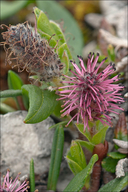|
|
click photo for larger file

Salix alpina
Alpine Willow
|
Photographer: Dr. Amadej Trnkoczy
ID: 0000 0000 0216 2651 (2016-02-24)Copyright © 2016 Dr. Amadej Trnkoczy
|
|
INFORMATION PROVIDED WITH THE PHOTO
|
date of photo May 18, 2015
latitude 46.43281 longitude 13.63980
View on Google Maps.
location
Mt. Mangart plateau, south of mountain pass between Mt. Mangart and Mt. Mali vrh, toward the top of Mt. Mali vrh, East Julian Alps (Posočje, Slovenia)notes Slo.: alpska vrba - syn.: Salix jacquinii Host. - Habitat: mountain pasture; moderately inclined mountain slope, north aspect; shallow, skeletal, generally calcareous ground, locally probably somewhat acid (associated with Loiseleuria procumbens); sunny, open place; exposed to direct rain; elevation 1.930 m (6.330 feet); average precipitations ~ 3.000 mm/year, average temperature 0-2 deg C, alpine phytogeographical region. Substratum: soil among rocks. Comment: A few species of very large genus Salix (willows, which are usually more or less large trees or shrubs) drastically accommodated their habitus to harsh conditions in sub- and alpine elevations. Their growth is highly reduced, so they are only a few cm tall trees with true wooden braches. Some even hide their 'trunks' underground. These are so called dwarf willows. In Slovenian Alps we know five species of them. To distinguish them only from their leaves requires quite a bit of experience. When they bloom another problem arises. They are unisexual plants. This means that there exist male plants with male flowers (catkins) only and female plants with female flowers (catkins) only. Male and female catkins differ significantly in their appearance. So, one ends up with ten different but still similarly looking plants to be recognized. Still, quite a challenge! Salix alpina is the tallest of all five. Usually it is not much higher than a few cm, but it can be up to 30 cm tall. One can recognize its male plants by catkins, which have long violet-pink stamens. Catkins develop approximately at the same time as leaves, which are densely silvery hairy when young. Grown up leaves are more or less glabrous but at the edge distinctly fringed. Female catkins are densely silvery hairy and look similar to what we know as 'normal' silvery-gray willow catkins. When they ripe the fruits are glabrous (without hairs) and reddish. Salix alpina is restricted to East Alps and Carpathians. Ref.: (1) D. Aeschimann, K. Lauber, D.M. Moser, J.P. Theurillat, Flora Alpina, Vol. 1., Haupt (2004), p 462. (2) M.A. Fischer, W. Adler, K. Oswald, Exkursionsflora für Österreich, Liechtenstein und Südtirol, LO Landesmuseen, Linz, Austria (2005), p 440. (3) A. Martinči et all., Mala Flora Slovenije (Flora of Slovenia - Key) (in Slovenian), Tehnična Založba Slovenije (2007), p 467. (4) K.Lauber and G.Wagner, Flora Helvetica, 5. Auflage, Haupt (2012), p 414.camera Nikon D700/Nikkor Micro 105mm/f2.8
contributor's ID # Bot_875/2015_DSC6604 photo category: Plant - tree/shrub
|
MORE INFORMATION ABOUT THIS PLANT
|
| common names
Alpine Willow (photographer)
View all photos in CalPhotos of Salix alpina Check Google Images for Salix alpina |
|
The photographer's identification Salix alpina has not been reviewed. Click here to review or comment on the identification. |
|
Using this photo The thumbnail photo (128x192 pixels) on this page may be freely used for personal or academic purposes without prior permission under the Fair Use provisions of US copyright law as long as the photo is clearly credited with © 2016 Dr. Amadej Trnkoczy.
For other uses, or if you have questions, contact Dr. Amadej Trnkoczy amadej.trnkoczy[AT]siol.net. (Replace the [AT] with the @ symbol before sending an email.) |
|
|
